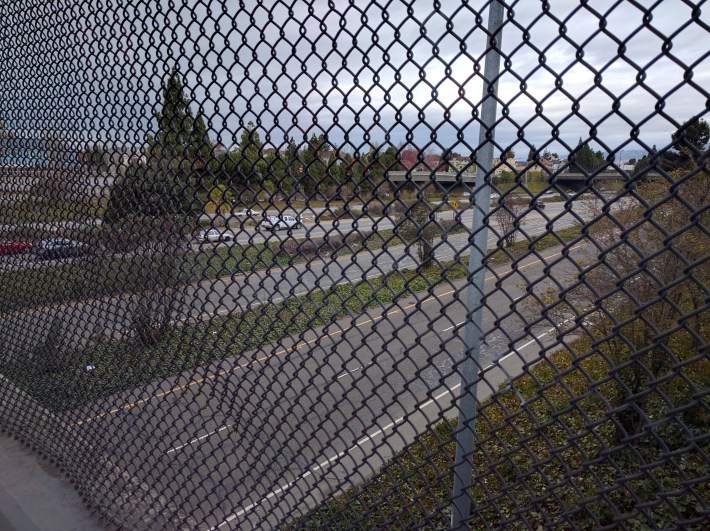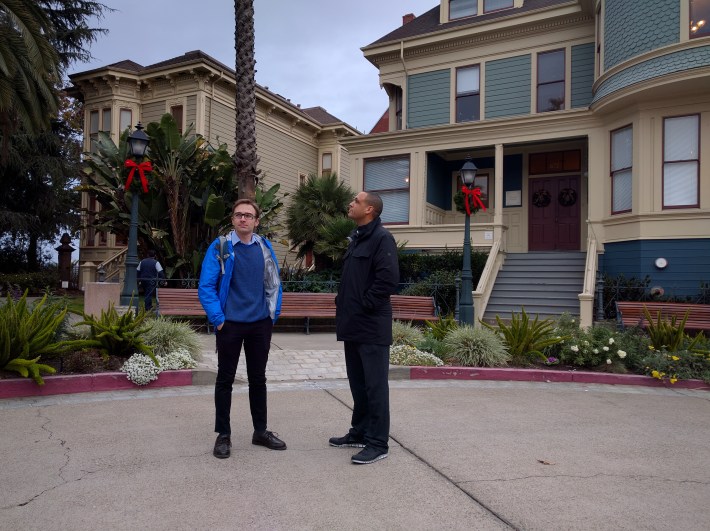
On a rainy morning in Preservation Park in Oakland, I met with Andrew Faulkner and Jonathan Fearn, advocates with “Connect Oakland,” to discuss their organization's vision to remove the 980 freeway, which sits between downtown and West Oakland.
“The 980 freeway was supposed to save downtown,” said Fearn. Instead, he explained, it became a 560-foot-wide asphalt moat, combining with the 880 and 580 to encircle West Oakland with wide freeways. Fearn and Faulkner see connections between the highway and many of West Oakland's problems.
“It's part of a larger pattern of dislocation and disinvestment in the community,” said Christopher Sensenig, an urban designer and founder of Connect Oakland.
The freeway resulted from an aborted attempt to build a second bridge from Oakland to San Francisco. Even though the bridge never happened, the road that would feed cars to and from it was already in motion. All the planning to build the 980 caused investors to abandon the area. Advocates for the freeway then sold it as a way to invigorate downtown Oakland, by building a giant “glorified offramp,” as Faulkner called it, that would lead directly into parking structures.
Such was the twisted logic and legacy of the highway-building era. Eventually, it wore down the anti-freeway coalition in Oakland, as advocates for the African American community, including the Black Panthers, bought into the idea and dropped their opposition, explained Faulkner and Fearn. The 980 finally opened in 1985.
Meanwhile, preservationists fought to save the old Victorian houses in the freeway's path. A handful of homes were moved to Preservation Park near the freeway's edge. The rest were obliterated.

Looking at the surviving houses and walking along the banks of this freeway, I was struck by how the same pattern scarred cities across America. When I was growing up, my relatives bemoaned the disastrous impact of the Cross Bronx Expressway on their once great neighborhoods in New York. Building freeways between cities is fine. But the uniquely American decision to cut up and obliterate historic city neighborhoods and downtowns for massive freeway projects is difficult to comprehend. “America really went all-in with this idea,” said Faulkner.
Faulkner, Fearn, Sensenig and other advocates with Connect Oakland are convinced the only cure for the 980 is to get rid of it. They point to the decision to remove the Embarcadero freeway in San Francisco and how that reinvigorated the surrounding area.
Many other cities have proposed capping freeways through downtowns. But Connect Oakland said that would be too expensive and complicated with the 980. Instead, they want to reduce the footprint of the road dramatically, transforming it into a 132-foot-wide surface-level boulevard with bike lanes, trees, and sidewalks.
The blocks that were destroyed by the 980 will be repaired. New blocks will be added. And a narrow section of the freeway gulch would be kept and covered to make space for a new BART and Caltrain tunnel that would eventually connect to the proposed second Transbay tube via Alameda.
In other words, they hope to reconnect West Oakland with downtown and provide mobility options far beyond I-980's current contribution. “This is an underutilized freeway anyway,” said Sensenig. “It's not even used by trucks.”
“The road carries 73,000 cars per day, making it one of the least traveled in the Bay Area,”said Faulkner. That level of traffic, he said, can be accommodated by the surface-level boulevard they're proposing. And if the BART and Caltrain connection comes, the corridor will carry over 200,000 people.
“We can triple the capacity with rail,” he said. “We just spent $4.6 billion on a new Bay Bridge eastern span and it's already at capacity -- and it has less capacity than it had in 1937, when it carried Oakland's historic Key Car trains,” Fearn added.
The idea is gaining support, including with Oakland Mayor Libby Schaaf. She has told Connect Oakland that "I-980 is a cautionary tale -- a broken promise of a second crossing that remains a scar on our urban fabric." The city has requested $5.2 million from the Alameda County Transportation Authority to study the conversion of I-980 into a second BART tube.
“Removing the 980 is a no-brainer,” said Sensenig.




